MITSUBISHI L200 2004 Owner's Manual (in English)
Manufacturer: MITSUBISHI, Model Year: 2004, Model line: L200, Model: MITSUBISHI L200 2004Pages: 264, PDF Size: 4.14 MB
Page 171 of 264

VEHICLE CARE
(4) Some types of hot water wash-
ing equipment apply high pres-
sure and heat to the vehicle.
They may cause heat distortion
and damage to the vehicle resin
parts and may result in flooding
of the vehicle interior. Therefore;
observe the following.
• Maintain a good distance of
approx. 40 cm or more be-
tween the vehicle body and the
washing nozzle.
• When washing around the
door glass, hold the nozzle at a
distance of more than 50 cm
and at right angles to the glass
surface.
(5) Using an automatic car wash,
pay attention to the following
items, referring to the operation
manual or consulting a car wash
operator. If the followings are
not followed, it could result in
damage to your vehicle.
• The outside mirrors and the
antenna are retracted.CAUTION(1) Waxes containing high abrasive
compounds should not be used.
Such waxes remove rust and
stain effectively from the paint-
work but they are harmful to the
lustre of the painted surface.
Further, they are harmful to
glossy surfaces such as grille,
garnish, mouldings, etc.
(2) Do not use petrol or paint thin-
ner to remove road tar or other
contamination to the painted
surface.
(3) Do not apply wax on the areas
having black mat coating as
it can cause uneven discolou-
ration, patches, blurs, etc. If
stained with wax, immediately
wipe off with a piece of soft cloth
and warm water.
During cold weather
The salt and other chemicals spread on
the roads in some areas in winter can
have a harmful effect on the vehicle body.
You should therefore wash the vehicle as
often as possible in accordance with our
care-instructions. It is recommended to
have a preservative applied and the
underfloor protection checked at an
authorized MITSUBISHI dealer before
and after the cold weather season.
After washing your vehicle, wipe off all
waterdrops from the rubber parts around
the doors to prevent the doors from
freezing.
NOTE
To prevent freezing of the weatherstrip-
ping on the doors, bonnet, etc., they
should be treated with silicone spray.
WaxingEK33A-Af
Waxing the vehicle will help prevent the
adherence of dust and road chemicals to
the paintwork. Apply a wax solution after
washing the vehicle, or at least once every
three months to assist displacing of water.
Do not wax your vehicle in direct sunlight.
You should wax after the surfaces have
cooled.
7-5
07engL2_240082_4 22-01-2004 13:09 Page 7-5
Page 172 of 264
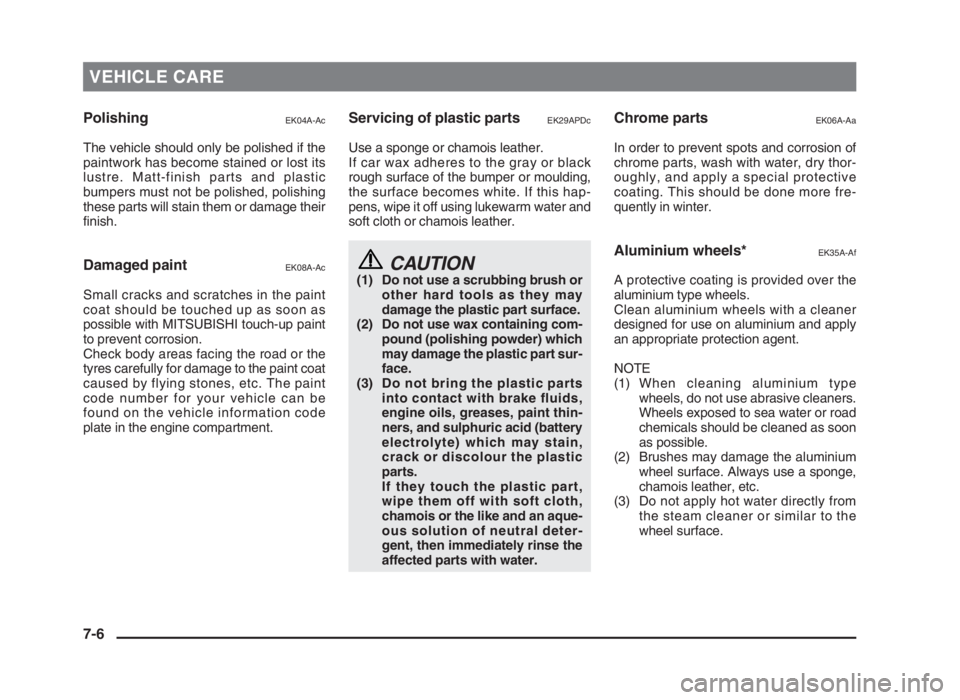
VEHICLE CARE
PolishingEK04A-Ac
The vehicle should only be polished if the
paintwork has become stained or lost its
lustre. Matt-finish parts and plastic
bumpers must not be polished, polishing
these parts will stain them or damage their
finish.
Damaged paintEK08A-Ac
Small cracks and scratches in the paint
coat should be touched up as soon as
possible with MITSUBISHI touch-up paint
to prevent corrosion.
Check body areas facing the road or the
tyres carefully for damage to the paint coat
caused by flying stones, etc. The paint
code number for your vehicle can be
found on the vehicle information code
plate in the engine compartment.
Servicing of plastic partsEK29APDc
Use a sponge or chamois leather.
If car wax adheres to the gray or black
rough surface of the bumper or moulding,
the surface becomes white. If this hap-
pens, wipe it off using lukewarm water and
soft cloth or chamois leather.
CAUTION(1) Do not use a scrubbing brush or
other hard tools as they may
damage the plastic part surface.
(2) Do not use wax containing com-
pound (polishing powder) which
may damage the plastic part sur-
face.
(3) Do not bring the plastic parts
into contact with brake fluids,
engine oils, greases, paint thin-
ners, and sulphuric acid (battery
electrolyte) which may stain,
crack or discolour the plastic
parts.
If they touch the plastic part,
wipe them off with soft cloth,
chamois or the like and an aque-
ous solution of neutral deter-
gent, then immediately rinse the
affected parts with water.
Chrome partsEK06A-Aa
In order to prevent spots and corrosion of
chrome parts, wash with water, dry thor-
oughly, and apply a special protective
coating. This should be done more fre-
quently in winter.
Aluminium wheels*EK35A-Af
A protective coating is provided over the
aluminium type wheels.
Clean aluminium wheels with a cleaner
designed for use on aluminium and apply
an appropriate protection agent.
NOTE
(1) When cleaning aluminium type
wheels, do not use abrasive cleaners.
Wheels exposed to sea water or road
chemicals should be cleaned as soon
as possible.
(2) Brushes may damage the aluminium
wheel surface. Always use a sponge,
chamois leather, etc.
(3) Do not apply hot water directly from
the steam cleaner or similar to the
wheel surface.
7-6
07engL2_240082_4 22-01-2004 13:09 Page 7-6
Page 173 of 264
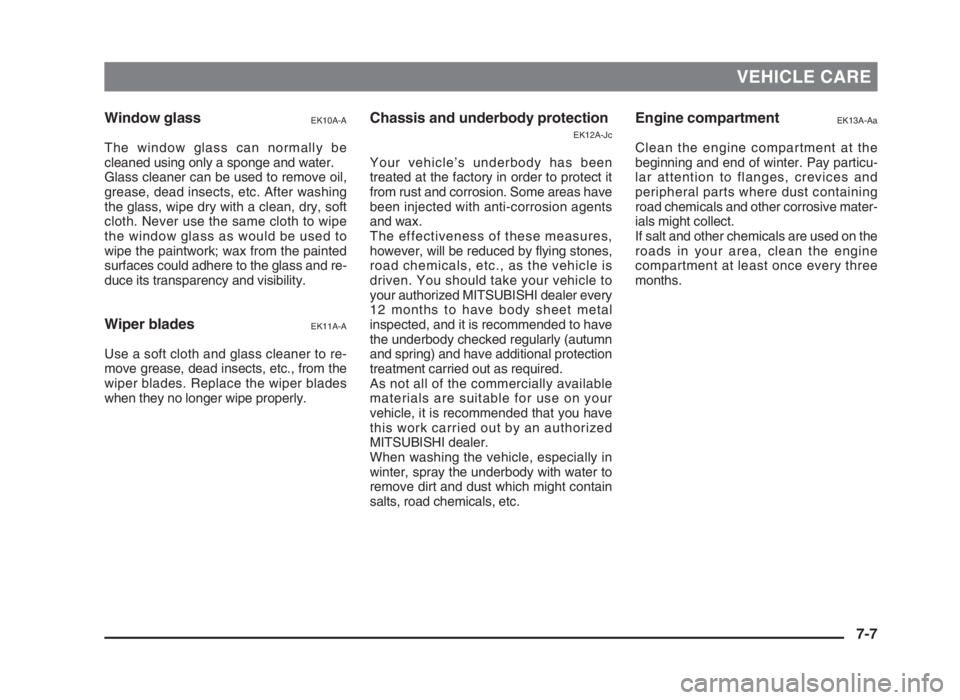
VEHICLE CARE
Window glassEK10A-A
The window glass can normally be
cleaned using only a sponge and water.
Glass cleaner can be used to remove oil,
grease, dead insects, etc. After washing
the glass, wipe dry with a clean, dry, soft
cloth. Never use the same cloth to wipe
the window glass as would be used to
wipe the paintwork; wax from the painted
surfaces could adhere to the glass and re-
duce its transparency and visibility.
Wiper bladesEK11A-A
Use a soft cloth and glass cleaner to re-
move grease, dead insects, etc., from the
wiper blades. Replace the wiper blades
when they no longer wipe properly.
Engine compartmentEK13A-Aa
Clean the engine compartment at the
beginning and end of winter. Pay particu-
lar attention to flanges, crevices and
peripheral parts where dust containing
road chemicals and other corrosive mater-
ials might collect.
If salt and other chemicals are used on the
roads in your area, clean the engine
compartment at least once every three
months.
Chassis and underbody protection
EK12A-Jc
Your vehicle’s underbody has been
treated at the factory in order to protect it
from rust and corrosion. Some areas have
been injected with anti-corrosion agents
and wax.
The effectiveness of these measures,
however, will be reduced by flying stones,
road chemicals, etc., as the vehicle is
driven. You should take your vehicle to
your authorized MITSUBISHI dealer every
12 months to have body sheet metal
inspected, and it is recommended to have
the underbody checked regularly (autumn
and spring) and have additional protection
treatment carried out as required.
As not all of the commercially available
materials are suitable for use on your
vehicle, it is recommended that you have
this work carried out by an authorized
MITSUBISHI dealer.
When washing the vehicle, especially in
winter, spray the underbody with water to
remove dirt and dust which might contain
salts, road chemicals, etc.
7-7
07engL2_240082_4 22-01-2004 13:09 Page 7-7
Page 174 of 264

07engL2_240082_4 22-01-2004 13:09 Page 7-8
Page 175 of 264
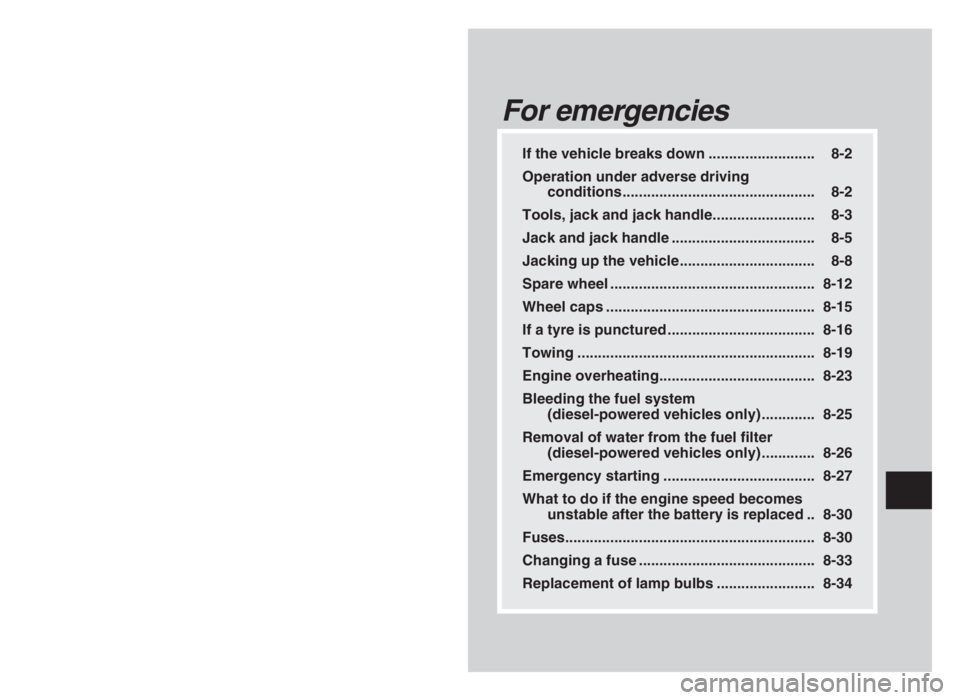
If the vehicle breaks down .......................... 8-2
Operation under adverse driving
conditions............................................... 8-2
Tools, jack and jack handle......................... 8-3
Jack and jack handle ................................... 8-5
Jacking up the vehicle................................. 8-8
Spare wheel .................................................. 8-12
Wheel caps ................................................... 8-15
If a tyre is punctured .................................... 8-16
Towing .......................................................... 8-19
Engine overheating...................................... 8-23
Bleeding the fuel system
(diesel-powered vehicles only) ............. 8-25
Removal of water from the fuel filter
(diesel-powered vehicles only) ............. 8-26
Emergency starting ..................................... 8-27
What to do if the engine speed becomes
unstable after the battery is replaced .. 8-30
Fuses............................................................. 8-30
Changing a fuse ........................................... 8-33
Replacement of lamp bulbs ........................ 8-34
For emergencies
8
08engL2_240082_4 22-01-2004 13:10 Page 8-1
Page 176 of 264
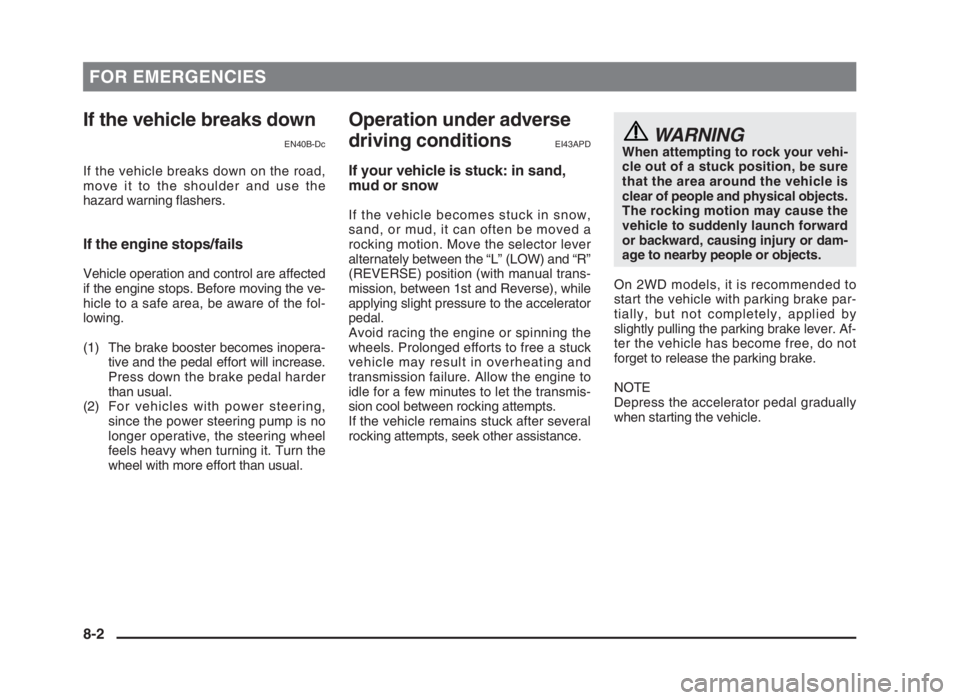
FOR EMERGENCIES
If the vehicle breaks down
EN40B-Dc
If the vehicle breaks down on the road,
move it to the shoulder and use the
hazard warning flashers.
If the engine stops/fails
Vehicle operation and control are affected
if the engine stops. Before moving the ve-
hicle to a safe area, be aware of the fol-
lowing.
(1) The brake booster becomes inopera-
tive and the pedal effort will increase.
Press down the brake pedal harder
than usual.
(2) For vehicles with power steering,
since the power steering pump is no
longer operative, the steering wheel
feels heavy when turning it. Turn the
wheel with more effort than usual.
Operation under adverse
driving conditions
EI43APD
If your vehicle is stuck: in sand,
mud or snow
If the vehicle becomes stuck in snow,
sand, or mud, it can often be moved a
rocking motion. Move the selector lever
alternately between the “L” (LOW) and “R”
(REVERSE) position (with manual trans-
mission, between 1st and Reverse), while
applying slight pressure to the accelerator
pedal.
Avoid racing the engine or spinning the
wheels. Prolonged efforts to free a stuck
vehicle may result in overheating and
transmission failure. Allow the engine to
idle for a few minutes to let the transmis-
sion cool between rocking attempts.
If the vehicle remains stuck after several
rocking attempts, seek other assistance.
WARNINGWhen attempting to rock your vehi-
cle out of a stuck position, be sure
that the area around the vehicle is
clear of people and physical objects.
The rocking motion may cause the
vehicle to suddenly launch forward
or backward, causing injury or dam-
age to nearby people or objects.
On 2WD models, it is recommended to
start the vehicle with parking brake par-
tially, but not completely, applied by
slightly pulling the parking brake lever. Af-
ter the vehicle has become free, do not
forget to release the parking brake.
NOTE
Depress the accelerator pedal gradually
when starting the vehicle.
8-2
08engL2_240082_4 22-01-2004 13:10 Page 8-2
Page 177 of 264

FOR EMERGENCIES
On a flooded road
(1) Avoid flooded roads. Water could
enter the brake discs, resulting in
temporarily ineffective brakes. In such
cases, lightly depress the brake pedal
to see if the brakes operate properly.
If they do not, lightly depress the
pedal several times while driving in
order to dry the brake pads.
(2) When driving in rain or on a road with
many puddles a layer of water may
form between the tyres and the road
surface.
This reduces a tyre’s frictional
resistance on the road, resulting in
loss of steering stability and braking
capability.
To cope with this, observe the follow-
ing items:
(a) Drive your vehicle at a slow speed.
(b) Do not drive on worn tyres. Always
maintain the specified tyre inflation
pressures.
Tools, jack and jack handle
EN01A-T
The storage location of the tools and jack
should be remembered in case of an
emergency.
Location
1 - Tools
2 - Jack
3 - Jack handle
On a snow-covered or frozen road
(1) When driving on a snow-covered or
frozen road, it is recommended that
you use snow tyres or tyre chains.
Refer to the “Snow tyres” and “Tyre
chains” sections.
(2) Avoid high-speed operation, sudden
acceleration, abrupt brake application
and sharp cornering.
(3) Depressing the brake pedal during
travel on such a road may cause tyre
slippage and skidding. When traction
between the tyres and the road is re-
duced the wheels may skid and the
vehicle cannot readily be brought to a
stop by conventional braking tech-
niques. Braking will differ, depending
upon whether you have anti-lock
brakes (ABS). If you do have ABS,
brake by pressing the brake pedal
hard, and keeping it pressed. If you
do not have ABS, pump the brake
pedal with short rapid jabs, each time
fully applying and fully releasing for
greatest effect.
(4) Allow extra distance between your
vehicle and the vehicle in front of you,
and avoid sudden braking.
8-3
N01A044
3
2
1
Single cab
08engL2_240082_4 22-01-2004 13:10 Page 8-3
Page 178 of 264
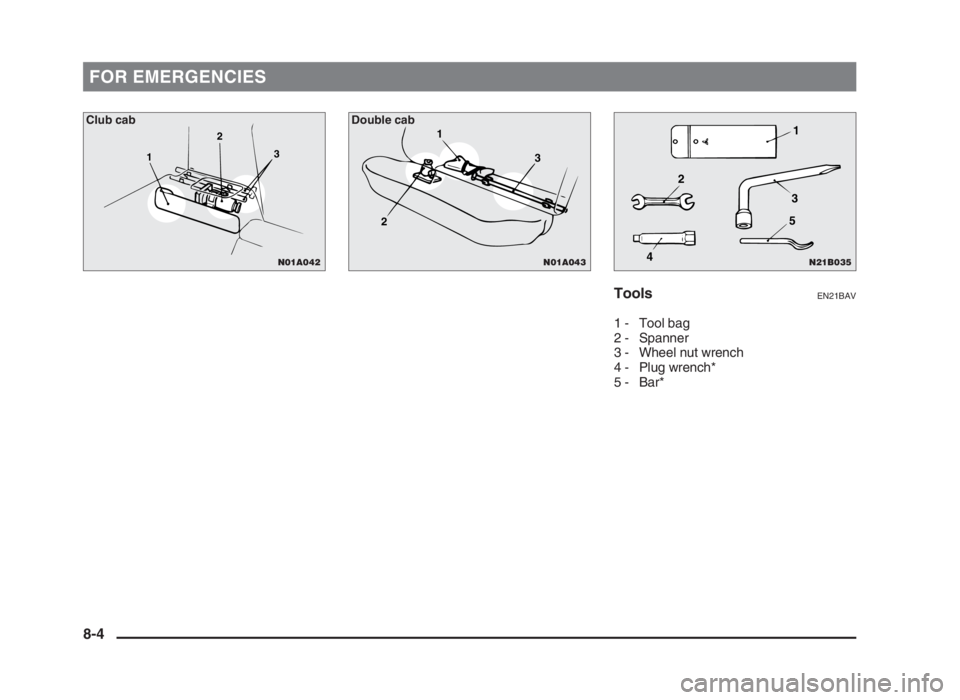
FOR EMERGENCIES
ToolsEN21BAV
1 - Tool bag
2 - Spanner
3 - Wheel nut wrench
4 - Plug wrench*
5 - Bar*
8-4
N01A043
21
3
N21B035
2
4531
Double cab
N01A042
12
3
Club cab
08engL2_240082_4 22-01-2004 13:10 Page 8-4
Page 179 of 264
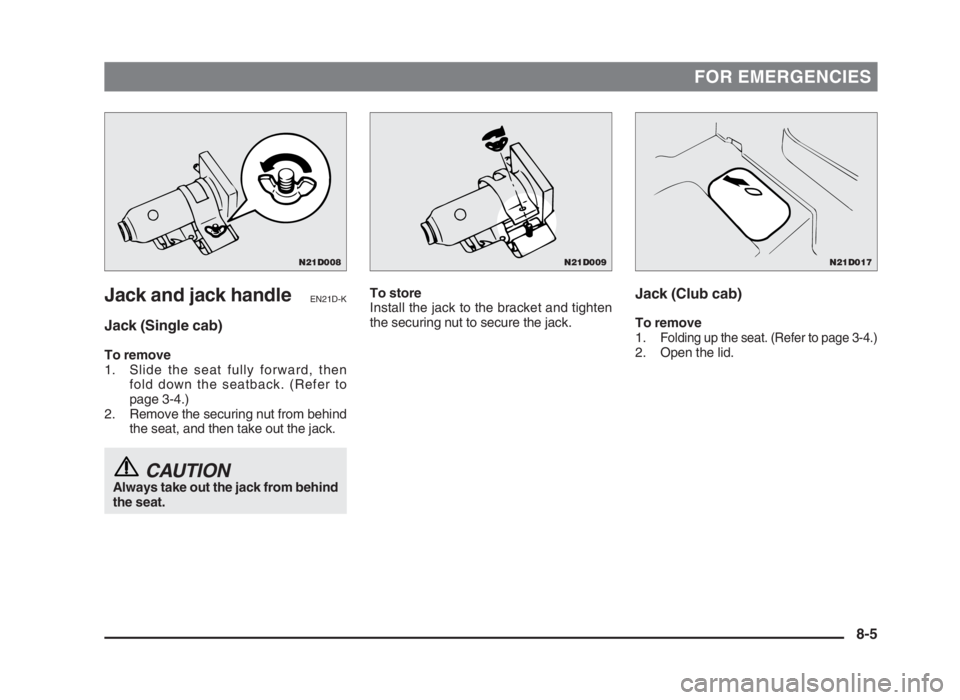
FOR EMERGENCIES
Jack and jack handleEN21D-K
Jack (Single cab)
To remove
1. Slide the seat fully forward, then
fold down the seatback. (Refer to
page 3-4.)
2. Remove the securing nut from behind
the seat, and then take out the jack.
CAUTIONAlways take out the jack from behind
the seat.
Jack (Club cab)
To remove
1.Folding up the seat. (Refer to page 3-4.)2. Open the lid. To store
Install the jack to the bracket and tighten
the securing nut to secure the jack.
8-5
N21D009N21D017N21D008
08engL2_240082_4 22-01-2004 13:10 Page 8-5
Page 180 of 264
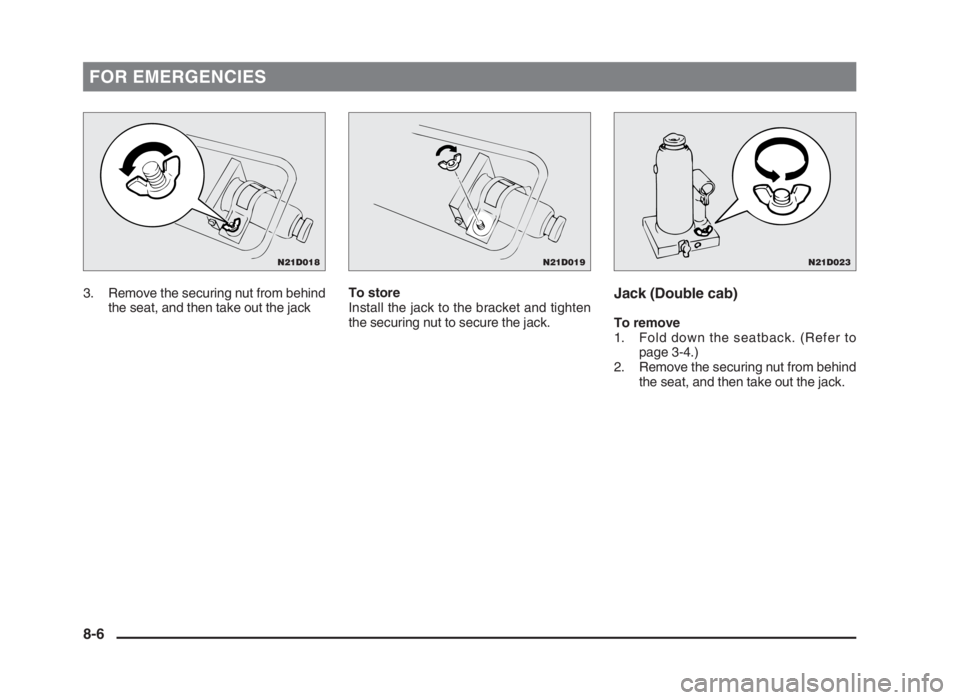
FOR EMERGENCIES
3. Remove the securing nut from behind
the seat, and then take out the jackTo store
Install the jack to the bracket and tighten
the securing nut to secure the jack.Jack (Double cab)
To remove
1. Fold down the seatback. (Refer to
page 3-4.)
2. Remove the securing nut from behind
the seat, and then take out the jack.
8-6
N21D019N21D023N21D018
08engL2_240082_4 22-01-2004 13:10 Page 8-6